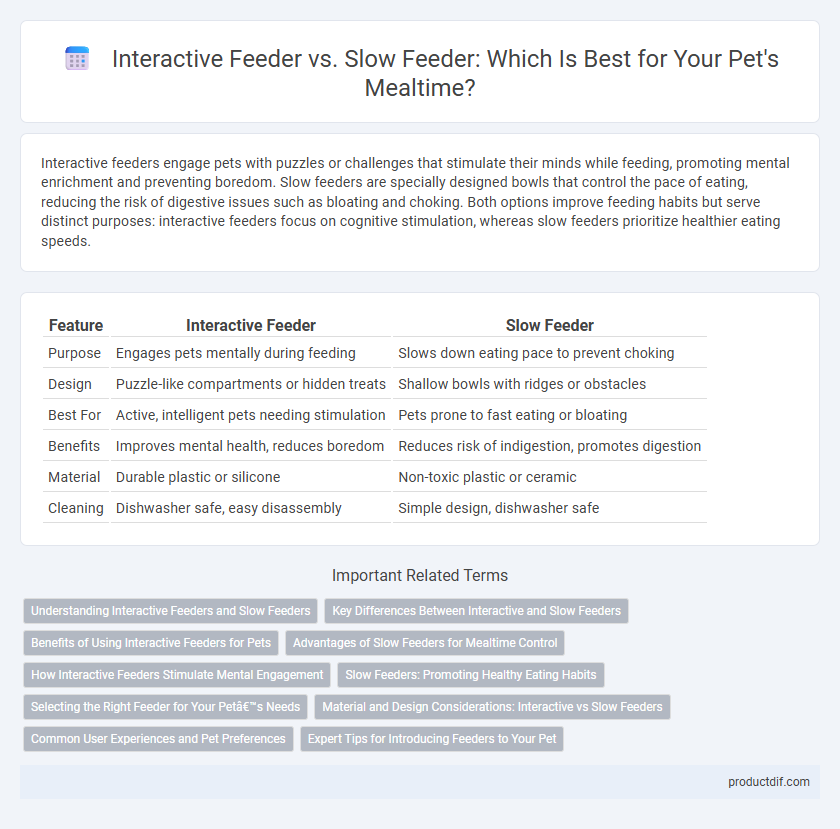Interactive feeders engage pets with puzzles or challenges that stimulate their minds while feeding, promoting mental enrichment and preventing boredom. Slow feeders are specially designed bowls that control the pace of eating, reducing the risk of digestive issues such as bloating and choking. Both options improve feeding habits but serve distinct purposes: interactive feeders focus on cognitive stimulation, whereas slow feeders prioritize healthier eating speeds.
Table of Comparison
| Feature | Interactive Feeder | Slow Feeder |
|---|---|---|
| Purpose | Engages pets mentally during feeding | Slows down eating pace to prevent choking |
| Design | Puzzle-like compartments or hidden treats | Shallow bowls with ridges or obstacles |
| Best For | Active, intelligent pets needing stimulation | Pets prone to fast eating or bloating |
| Benefits | Improves mental health, reduces boredom | Reduces risk of indigestion, promotes digestion |
| Material | Durable plastic or silicone | Non-toxic plastic or ceramic |
| Cleaning | Dishwasher safe, easy disassembly | Simple design, dishwasher safe |
Understanding Interactive Feeders and Slow Feeders
Interactive feeders engage pets by incorporating puzzles or activities that stimulate their problem-solving skills while controlling food intake to prevent overeating. Slow feeders are designed with built-in barriers or compartments that naturally reduce the pet's eating speed, promoting better digestion and reducing risks of bloating. Both types of feeders enhance mealtime by addressing feeding behaviors but differ in the level of mental engagement they provide for pets.
Key Differences Between Interactive and Slow Feeders
Interactive feeders challenge pets mentally by requiring problem-solving to access food, promoting engagement and reducing boredom. Slow feeders primarily focus on reducing eating speed through maze-like designs, preventing digestive issues like bloating and choking. Interactive feeders often offer adjustable difficulty levels, whereas slow feeders typically have static patterns aimed at controlling portion intake speed.
Benefits of Using Interactive Feeders for Pets
Interactive feeders for pets promote mental stimulation and reduce boredom by engaging pets in problem-solving tasks during mealtime. These feeders help slow down eating, which improves digestion and decreases the risk of bloating or obesity. Unlike traditional slow feeders, interactive feeders offer varied challenges that enhance cognitive skills and encourage natural foraging behavior.
Advantages of Slow Feeders for Mealtime Control
Slow feeders effectively regulate portion sizes and promote healthier eating habits by reducing the speed at which pets consume their food, minimizing the risk of choking and digestive issues. These feeders encourage longer mealtime engagement, aiding in better digestion and preventing overeating, which supports weight management. Built with strategically placed obstacles, slow feeders stimulate mental activity while controlling calorie intake, making them an essential tool for pets prone to rapid eating.
How Interactive Feeders Stimulate Mental Engagement
Interactive feeders encourage pets to solve puzzles or manipulate parts to access food, promoting cognitive skills and problem-solving abilities. Unlike slow feeders that primarily regulate eating speed, interactive feeders engage pets mentally by requiring active participation during mealtime. This mental stimulation helps reduce boredom and anxiety, contributing to healthier and more dynamic feeding experiences.
Slow Feeders: Promoting Healthy Eating Habits
Slow feeders encourage pets to eat at a controlled pace, reducing the risk of bloating, obesity, and digestive problems. Designed with maze-like compartments or small openings, these feeders challenge pets to work for their food, promoting mental stimulation and preventing gulping. Studies show that slow feeding improves nutrient absorption and supports long-term healthy eating habits in cats and dogs.
Selecting the Right Feeder for Your Pet’s Needs
Interactive feeders engage pets by combining mental stimulation and food rewards, ideal for highly active and intelligent pets needing physical and cognitive challenges. Slow feeders are designed to reduce rapid eating, promoting better digestion and preventing obesity, making them suitable for pets prone to gulping food or with digestive issues. Selecting the right feeder depends on your pet's activity level, eating habits, and health requirements, ensuring optimal feeding behavior and overall well-being.
Material and Design Considerations: Interactive vs Slow Feeders
Interactive and slow feeders are typically made from durable, non-toxic materials such as BPA-free plastic, silicone, or stainless steel to ensure safety and longevity. Interactive feeders feature complex designs like compartments, lids, or puzzles to stimulate pets mentally while controlling food intake. Slow feeders usually have textured surfaces with ridges or maze patterns that promote slower eating and improve digestion by making pets work harder to access their food.
Common User Experiences and Pet Preferences
Interactive feeders engage pets by stimulating their natural hunting instincts and providing mental challenges, which many pet owners report helps reduce boredom and anxiety. Slow feeders are designed to prolong mealtime, preventing overeating and promoting better digestion, with common user feedback highlighting improvements in pets' eating habits and reduced choking risks. Pet preferences often depend on activity level and temperament, with more active or intelligent pets benefiting from interactive feeders, while slow feeders suit pets that tend to eat too quickly.
Expert Tips for Introducing Feeders to Your Pet
Expert tips for introducing interactive feeders and slow feeders to your pet emphasize gradual adaptation to prevent stress and encourage engagement. Begin by placing the feeder in your pet's regular feeding area, allowing them to explore without pressure, and reward curiosity with treats or praise. Monitor your pet's behavior closely, adjusting the difficulty level and feeding duration to ensure positive reinforcement and prevent frustration during the transition.
Interactive feeder vs Slow feeder Infographic

 productdif.com
productdif.com